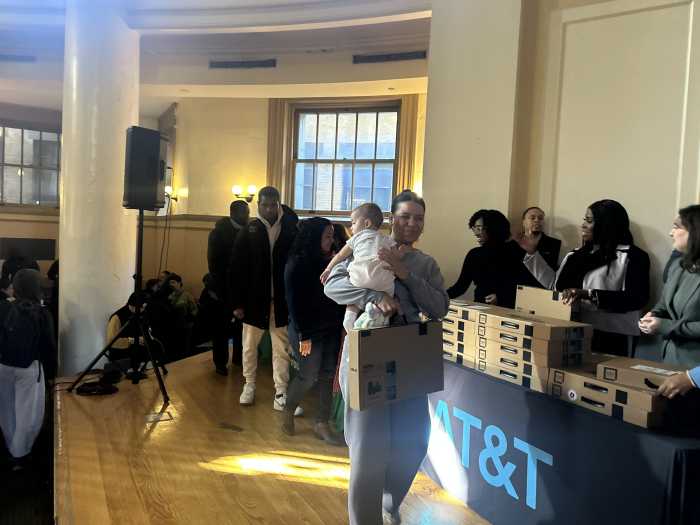When the Ingersoll Senior Residences adjacent to Fort Greene Park on Brooklyn’s Myrtle Avenue open for occupancy as early as next month, the 16-story, 145-unit apartment building will not be the nation’s first affordable, LGBTQ-friendly elder housing development. But it will be the largest to date.
Created through a partnership between SAGE, Advocacy & Services for LGBT Elders, and the development firm BFC Partners, Ingersoll is also unique, said SAGE CEO Michael Adams, in being “intentionally built as an intersectional community.”
Similar LGBTQ-friendly senior housing already exists in cities including Philadelphia, Chicago, Minneapolis, San Francisco, and Los Angeles — and have typically been sited in the “gayborhood,” in New York generally thought to be Chelsea, a predominantly white community that has become increasingly expensive.
The greatest need for affordable housing to serve LGBTQ seniors in New York, however, is in communities of color. For that reason, Adams explained, for the first two projects his group embarked on here, SAGE chose Fort Greene, a longtime African-American community, and the largely Spanish-speaking East Tremont section of the Bronx, where a second development, Crotona Senior Residences, will open at a site across from Crotona Park in early 2020.
Ingersoll is built on the existing grounds of the New York City Housing Authority (NYCHA) Ingersoll Houses in a neighborhood that is undergoing widespread gentrification. In fact, the new building is not so different in appearance from upscale apartment and condo high rises that have mushroomed throughout Fort Greene and Downtown Brooklyn, leading some Ingersoll Houses residents and their neighbors to worry, Adams said, that the new senior development is a part of that wave.
In fact, the ground rules for accepting applicants to the Ingersoll Residences were set up to serve seniors with the greatest need. Under the income limits that govern renting in the building, where tenants will make use of federal Section 8 vouchers, couples have an income upper limit of just under $42,000, while single residents face a cap of just under $37,000.

Fifty-four of the units are reserved for people who already live in NYCHA housing or are wait-listed for it, while 25 percent of the units will go to those who have been homeless. On that second criterion, SAGE had to shape a novel approach to work around how the city generally defines meeting that requirement. Homeless status under existing affordable housing programs has meant living in a shelter, but SAGE successfully argued that many members of the LGBTQ community without a permanent home avoid the shelters out of concern about their safety around other residents who may harbor homophobic and transphobic prejudices. SAGE and the city were able to come to agreement on a more flexible definition of what qualifies as having been homeless.
Under city and state nondiscrimination statutes, of course, Ingersoll cannot rent exclusively to LGBTQ seniors, and Adams estimated that almost half of the initial residents will be non-LGBTQ, even as the building in other important respects is designed to meet the specific needs of the queer community, both in terms of “wrap-around” social and health services and in having a 6,000-square-foot SAGE Center on site. That Center will serve both Ingersoll residents and the outside community. Though SAGE will not own or manage the residential building, it will oversee the Center, which will include case management and urgent health care aimed at providing a bridge to fuller service providers.
In a city as vast and expensive as New York, there is a crying need for affordable housing for seniors from all its diverse communities, but SAGE’s recognition of the specific needs facing LGBTQ elders is evidence-based. A survey of 3,000 LGBTQ elders by SAGE found significant anxiety about facing discrimination in senior housing and that those elders are more likely than their straight peers to live alone and, especially among lesbians and transgender folks, have fewer financial resources. One in eight gay men and lesbians reported facing discrimination in searching for senior housing, with a full 25 percent of transgender people reporting the same.
A 10-state study carried out by the Equal Rights Center found that discrimination is more widespread than community members themselves perceive or report. Two hundred pairs of same-sex and different-sex couples were sent into senior housing facilities as testers to identify discrimination. In 48 percent of the tests across the 10 states, the experiment uncovered discrimination against gay and lesbian applicants. Discrimination occurred even in states and localities with LGBTQ civil rights protections, the best state of the 10 producing discrimination in more than a quarter of all tests.
This past spring’s application window for Ingersoll proved its appeal. For 145 units — 84 one-bedrooms for couples and 61 studios for single people — only 2,000 applications online applications were going to be accepted. Within three hours, 1,600 had already been filed. A successful applicant for the 145 slots would have to have filed within the first eight minutes.
In providing LGBTQ-friendly housing, SAGE is mindful that in any 16-story building with both LGBTQ and non-LGBTQ residents even ordinary conflicts between neighbors could take an unfortunate turn involving hostile anti-gay or anti-trans sentiments being voiced. But Adams noted the self-selection involved in non-LGBTQ people applying to live in an LGBTQ-friendly building. He also emphasized that a SAGE staff of at least five will be on hand in the building and that the group has reached out to similar facilities in other cities to discuss successful conflict mediation strategies. An important part of the new residents’ orientation, he said, would focus on forging a “group” spirit among the tenants.

SAGE will have little time to rest on its laurels once Ingersoll opens, with the 84-unit Crotona Senior Residences, of which SAGE is a part owner, opening up in the Bronx in February or March of next year. There, a seven-story building with 55 studios and 29 one-bedroom apartments, will house the winners of a tenant lottery. Thirty percent of the units there are reserved for homeless elders. That building will host the city’s biggest SAGE Center, at 9,800-square feet.
SAGE is sharing the expertise it has developed in steering these projects to completion with at least a dozen communities around the country, eight of which are planning similar LGBTQ-friendly residential construction. The group has developed a primer for LGBTQ senior housing providers that includes case studies of many of the projects built to date. Adams said SAGE is also looking at the concept of home-sharing, where unattached seniors live together in a supportive, multi-bedroom group setting.
But SAGE is well aware that the community will not build its way out of the shortfall in hospitable options for LGBTQ elders. Many seniors will age in place, which requires that culturally competent social services for them are available in their neighborhoods. And SAGE is also working to engage mainstream housing sector players in learning how to employ best practices in making their developments open and inviting to seniors from the LGBTQ community.
On October 29, SAGE in collaboration with Citi Community Development hosted a day-long symposium on LGBTQ elder housing, a series of forums and discussions that brought together LGBTQ-friendly housing providers and other community advocates with leaders in the mainstream housing sector. The day explored needs faced by the LGBTQ senior community, models for creating friendly and affirming housing opportunities, and government policy efforts aimed at producing better results.
The day proved a busy one for SAGE in Washington. As the symposium took place, Adams was also on a panel of experts — that included Human Rights Campaign president Alphonso David and National Center for Transgender Equality policy director Harper Jean Tobin, as well, among others — before the House Financial Services Subcommittee on Oversight and Investigations for a hearing on housing and lending discrimination against the LGBTQ community.
The current administration in Washington, of course, is a brick wall right now for SAGE like so many other LGBTQ and progressive organizations. The October 29 symposium and House hearing, however, provided SAGE opportunities to continue both to push engagement with the broader housing sector and to address its public policy agenda with the Democratic House, against the day when a more amenable attitude prevails in the White House and in the US Senate.


















